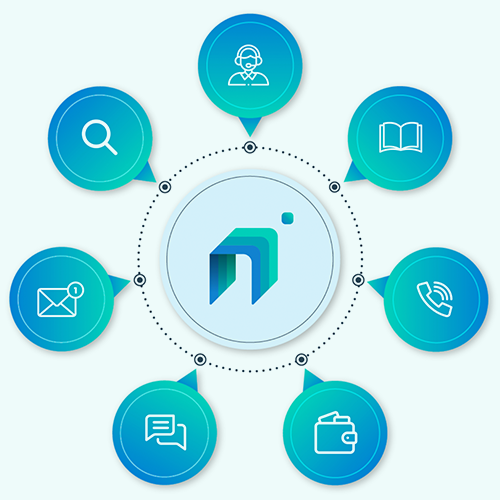Every human being (customer) is a unique entity and their feelings too.
I think most of you agree with my above statement, right!
“People will forget what you said, people will forget what you did, but people will never forget how you made them feel.”
As an enterprise, every day, your business will interact with thousands of customers via the contact center, and those thousands of people will react to your service differently.
When we coalesce overall opinions, you will get to know how the customers perceive that particular product.
That is all about sentiment analysis in a more straightforward format.
The contact center or customer support service is still using some traditional call routing methods, where the customer’s sentiment is given the least priority.
The conventional approaches will take simple metrics (Net promoter score) to analyze and route customers rather than in-depth analysis.
Improper call routing will affect customer engagement.
The low customer engagement is directly proportional to poor customer experience and loss of a customer temporarily or permanently.
It is where the need for intelligent routing begins for enterprises.
Follow us!
To know the process in detail.
In this blog, we take you through sentiment analysis and sentiment routing.
Let’s start with sentiment analysis, as there is no sentiment routing without it.
Sentiment routing
Now comes the intelligent sentiment routing part.
Sentiment routing is a feature that helps contact centers to create queues and automatically prioritize tickets depending on the sentiment analysis of the text.
The routing will depend on the threshold value assigned to the particular intent, and they are divided into three different buckets, such as positive, negative, and neutral.
The Conversational platform specifies keywords to look out and attaches scores to them.
The sentiment scores need to be neutralized to exonerate particularities in how customers articulate themselves to increase conversation rates without depending on the generated sentiments.
Note:With Nuacem’s sentiment routing systems, enterprises can train their platforms on how many failure intents should fall back to the human agent.
You can declare it as 3 or 5 based on your requirement.
Before we dig into the usage of sentiment routing for successful customer engagement, let’s know some technical basics about sentiment analysis.
Sentiment analysis
Sentiment analysis can be defined as a cluster of tools to classify and extort opinions and use them to benefit the organization’s operations.
It assigns a metric to a piece of intent that details whether the user intent is positive or negative.
It uses an algorithm that will use NLP, ML, and deep learning to analyze the customer’s feel, sentiment, and emotions.
You can call that metric as polarity, as it returns a value ranging from extremely negative (-1) to extremely positive(+1).
With the above verges’ help, comments are divided into positive, negative, and neutral.
How are we getting?
Sentiment analysis methods
There are three methods s we use to implement sentiment analysis they are:
Rule-based
It is the most straightforward kind of sentiment analysis method that uses an algorithm with a well-defined portrayal of opinion to discover.
It uses a basic NLP routine. It rivets the following operations using text corpus:
- Stemming
- Tokenization
- Parsing
- Lexicon analysis
Most companies use this system for the foundation for ensuing implementation and training of the ML solution.
It works well with explicit and implicit opinions and does not work with implicit opinions.
Automated systems
This system combines advanced ML algorithms, Natural Language understanding, NLP, and statistics to know the customers’ emotions and sentiment.
These systems learn over time, and it works with direct, implicit, explicit, and comparative opinions.
It also provides more accurate and precise results when compared with the rule-based systems without complicating the system.
Hybrid systems
It is the combination of both rule-based and automated systems.
It is more powerful, and with the hybrid system, you can improve precision and accuracy with ease.
What we are getting:
You can use sentiment analysis as an excellent tool for various purposes, such as:
- Expanded product analytics
- Reputation management
- Customer service
- Precision targeting
- Sentiment based routing
- Brand loyalty
Types of sentiment analysis
Every business should know types to apply for your business context.
Fine-grained
It determines the polarity of the opinion (positive or negative). It can go into more specification (favorable, more favorable, neutral, less favorable, and least favorable).
It is used mainly in the customer feedback, rating, and review process from existing customers. (Example: As in Flipkart reviews).
Emotion detection
Identifies signs of specific emotional states presented in the intent/text, the algorithms in this type determine what exactly it is and why.
Aspect based
It goes deeper to classify an opinion relating to an explicit element of the product/service.
Example: Sound clarity of the speakers on the smart tv.
It is usually used in product analytics to perceive strong and weak points from the customer end.
Intent analysis
It is about the actions to be taken based on the customers’ intent in a message.
The contact center systems will use this sentiment analysis to streamline the workflow between use and agent.
Now, let us shift our focus to know how sentiment routing helps enhance customer engagement.
Sentiment routing for successful customer engagement
As discussed in the previous posts, customer engagement is crucial for every brand, and most enterprises invest a considerable amount in improving customer engagement.
Today, we are going to see how sentiment routing improves customer engagement.
Targets customer individually
The sentiment analysis will track the customers who use strong negative keywords (Value -0.95) towards your service/product, and these issues will take care specifically.
If a customer asks repetitive questions or necessary information about the product, then the Conversational AI chatbot itself clears their issue by providing FAQs or knowledge base links.
As we make the sentiment score to zero levels by taking care of every customer with proper routing, the customer experience will increase, leading to successful customer engagement and satisfaction and loyal customers.
Customer prioritization
The NLP is used to prioritize and route messages. Our platform will plan and handle every type of customer intent, even more, complex ones.
The sentiment routing helps in prioritizing customers based on sentiment scores.
If the score is negative, the routing will be done to the executives related to that particular department (finance, HR, and other departments) agents.
Based on the email and chat customer interactions, agents will instantly determine the customer mood depending on the assigned sentiment attribute.
In both cases, customers are satisfied; they will continue to engage with your site rather than your competitors.
Wrapping up
I hope you got the information related to sentiment analysis and sentiment routing for successful customer engagement.
And these technologies will provide significant value to the businesses in a better understanding of the customer.
The usefulness of this technology will entirely depend on the individual organization how it uses.
If you are still not using a Conversational AI platform for sentiment routing, then get up and consult a good Conversational AI company.
We at Nuacem offer complete sentiment analysis solutions with the help of Conversational AI.
Don’t sway to reach us!
Our tech professionals will always there to help you out in giving you the best optimal solution.
Please stay connected with us! For more latest and attention-grabbing updates on Conversational AI, sentiment analysis, customer engagement, and automation.








